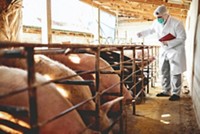Advertisement
Grab your lab coat. Let's get started
Welcome!
Welcome!
Create an account below to get 6 C&EN articles per month, receive newsletters and more - all free.
It seems this is your first time logging in online. Please enter the following information to continue.
As an ACS member you automatically get access to this site. All we need is few more details to create your reading experience.
Not you? Sign in with a different account.
Not you? Sign in with a different account.
ERROR 1
ERROR 1
ERROR 2
ERROR 2
ERROR 2
ERROR 2
ERROR 2
Password and Confirm password must match.
If you have an ACS member number, please enter it here so we can link this account to your membership. (optional)
ERROR 2
ACS values your privacy. By submitting your information, you are gaining access to C&EN and subscribing to our weekly newsletter. We use the information you provide to make your reading experience better, and we will never sell your data to third party members.
Infectious disease
Global sewage survey maps antimicrobial resistance
Wastewater monitoring could help tackle antimicrobial resistance
by Laura Howes
March 14, 2019
| A version of this story appeared in
Volume 97, Issue 11

Infectious-disease surveillance programs designed to track antimicrobial resistance face practical, ethical, and legal difficulties. Patient data must be anonymized, and it can be difficult to compare data collected from different countries and hospitals. The answer to these challenges, an international team believes, is sewage (Nat. Commun. 2019, DOI: 10.1038/s41467-019-08853-3).
Led by Frank Aarestrup at the Technical University of Denmark, researchers recruited people at 79 sites in 60 countries to the Global Sewage Surveillance Project. Those volunteers collected sewage samples and sent them to Denmark, where researchers looked for genes coding for antimicrobial resistance. They found global and regional differences in antimicrobial-resistance gene diversity and abundance. Microbes in samples from Australia, New Zealand, North America, and western Europe generally had lower levels of antimicrobial resistance; those from Asia, Africa, and South America generally had higher levels. The study found that sanitary conditions and the general health of the population were most strongly associated with a country’s level of antimicrobial resistance. To combat this growing problem, the researchers say, the most effective strategy may be to improve sanitary conditions and monitor progress by continuing to test for resistance genes in sewage.



Join the conversation
Contact the reporter
Submit a Letter to the Editor for publication
Engage with us on Twitter